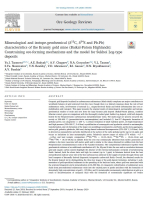Добрый день, Коллеги. Важное сообщение, просьба принять участие. Музей Ферсмана ищет помощь для реставрационных работ в помещении. Подробности по ссылке
Mineralogical and isotope-geochemical (.13C, .34S and Pb-Pb) characteristics of the Krasniy gold mine (Baikal-Patom Highlands): Constraining ore-forming mechanisms and the model for Sukhoi Log-type deposits / Рудник Красный
Минералогические и изотопно-геохимические (.13C, .34S и Pb-Pb) характеристики золотого рудника "Красный" (Байкало-Патомское нагорье): сдерживающие механизмы рудообразования и модель для месторождений типа Сухого Лога
Orogenic gold deposits localized in carbonaceous sedimentary (black-shale) complexes are major contributors to worldwide balance of gold extracted from the crust, though there is a limited consensus about the role of host sedimentary rocks, involvement of external (i.e., magma-derived) fluids and brittle deformations into ore remobilization and transport. This paper presents the original results of mineralogical, petrographic and isotopegeochemical
studies of rocks and ores from the large Krasniy gold deposit (Baikal-Patom plateau, southern Siberian craton) given in comparison with the thoroughly studied giant Sukhoi Log deposit, with both deposits hosted by the Neoproterozoic carbonaceous metasedimentary rocks. The multi-stage ore process occurred discretely at 200–400 °C (greenschist-facies metamorphism) and included (1) low-P-T diagenetic formation of globular pyrite, (2) catagenetic (< 200 °C, 1–2 kbar) formation of small euhedral pyrite, (3) high-temperature and high-pressure (300–380 °C, 5–6 kbar) crystallization of arsenopyrite and pyrrhotite related to metamorphic transformation, and (4) formation of the major ore assemblage (arsenopyrite, pyrrhotite, pyrite meta-aggregates, native gold, galenite, sphalerite, fahl ores) during almost isothermal decompression (270–320 °C, 0.5 kbar). Gold is detected as nanoparticles unevenly distributed at the surface of the early globular pyrite (up to 0.4 ppm) and occurs as inclusions in later metamorphic pyrite. Relatively narrow ranges of sulfur (.34S within .4.7 – .6.9‰) and lead isotopic composition (206Pb/204Pb = 18.33–18.65, 207Pb/204Pb = 15.65–15.68 and 208Pb/204Pb = 38.13–38.82) in sulfides from the ores was continuously inherited from earlier generation of sulfides to the later (associate with native gold) and is similar to the values obtained for sulfides from the host Neoproterozoic metasedimentary rocks of the Aunakit formation. The compositional inheritance together with geochemical evidence of no additional contribution of К, Na, Mg and Si into the ores and no correlation between gold and organic carbon content highlight the absence of the external metasomatic overprint of metal-bearing fluids. Instead, both the above facts and high Au content (up to 1 ppm) in bitumens derived from the host metasediments indicate a key role of the host carbonaceous substrate in the supply of metals through release and local transport of Internally derived diagenetic/catagenetic carbon-rich fluids. Overall, the obtained results for the Krasniy deposit led to distinguishing the three key stages of the gold deposit formation, including 1) sedimentation of gold-specialized sediments in the spreading of the back-arc basin, where gold was associated with the scattered diagenetic pyrite mineralization (610–590 Ma), 2) catagenetic redistribution of sedimentary pore fluids from preconditioned sedimentary rocks into the vaulted parts of gentle anticlines with the formation of abnormally high concentrations of gold (~570 Ma), and 3) metamorphic-metasomatic redistribution of gold as a result of decarbonization of catagenic fluid with the formation of economically significant ore bodies (450–420 Ma). The compilation of the available geochemical and isotopic data allows to suspect this model as a general for the other Bodaibo region deposits, so that it can be used further for prediction and exploration purposes




